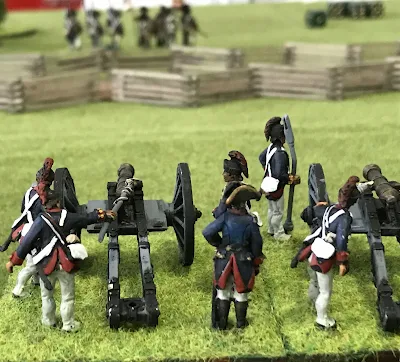I was asked recently by a friend about these two books. How different are they and are they worth getting? Another fruend asked me if they are just the same thing with different covers or if they duplicate the same materials. To answer those questions here is a shirt review of my opinion about these books. Both of which I own.
The War of 1812: A Campaign Guide to the War with America 1812-1815
Opening this book at the On Military Matters stand at Cold Wars a few years ago I was delighted right away. It is a book a wargamer would write. One who loved the period. Well written, lots of illustrations and bunches of helpful details. Just the stuff you need if starting the period or are an old hand who needs inspiration. I bought it right away.
As far as the content of the book it can be described as being in three parts. The first third of the book is devoted to a general history of the war per year (from 1812 to 1815). There is also a chapter devoted to the naval aspects of the war. The text is short, clear, and very understandable. most of the illustrations in this section are old prints and maps; many out of Benjamin Lossing's Field Book of The War of 1812.
The next section is devoted to the armies; British, Canadian United States and Indians. This section describes the composition of armies and the uniforms worn. Many are of obscure small units. Great details here and very handy. A small part is devoted to the “Indians” (Native Americans), about their involvement in the war and the main actions involving them.
The illustrations here are worth The price of the book. There are a number of outstanding uniform plates by Bob Marrion. There are also numerous photographs of reenactors here. It is interesting to see the uniforms and how they look on real people rather then miniatures
The third and last part is wargaming the War of 1812. How to integrate the tactical particularities of this unusual war into a set of rules. The quality and types of troops, what figures are available and where to get them. All scales are mentioned. numerous pictures of wargamer figures illustrate this section. The figures are usually 25mm Wargame Foundry or 54mm figures. Please keep in mind the wonderful line of figures from Knuckleduster are not listed as they were not yet created when this book was written.
It is also an expensive book. Because it is hardback and filled with colorful illustrations. But you get a book that will last and you will return to time and again.
Scenarios for the War of 1812-1815
This scenario booklet has been written with the wargamer in mind. If you are looking for a quick guide to some of the important actions and how to Guggenheim on your table top here is your guide.
After a capsule summary off the war the author lays out twelve battles forgoing fight. The battle listed are:
Queenston Heights, 13th October 1812
Raisin River, 18th/22nd January 1813
The Assault on York, 27th April 1813
Sacket's Harbor, 29th May 1813
Beaver Dams, 24th June 1813
Thames River, 5th October 1813
Chateaugay, 25th October 1813
Crysler's Farm, 11th November 1813
Chippawa, 15th July 1814
Lundy's Lane, 25th July 1814
Bladensburg, 24th August 1814
North Point, 12th September 1814
Here we have a good variety of actions. Some are obscure battles (Thames River), some skirmishes (Beaver Dam) and others stand up actions (Chippawa). There is something for every size collection here.
Each battle is played out in a similar manner. A potted history of the actual fight, a simple map of the battlefield, troops involved and suggestions on how to game the battle. Some people may say the maps are too simple, but to me they give a good representation of the ground. In summation everything you need to war game this unique conflict in your table too.














































